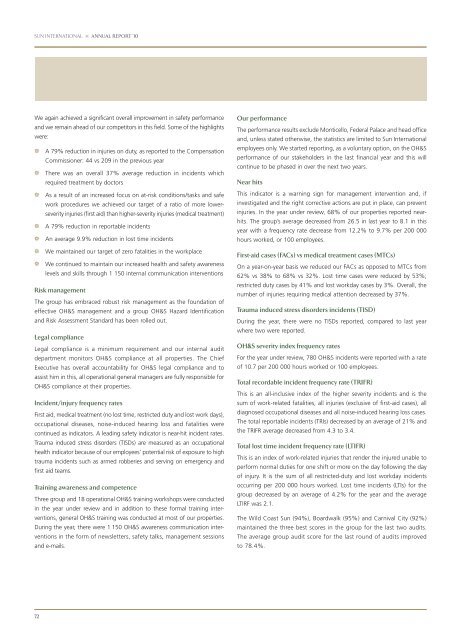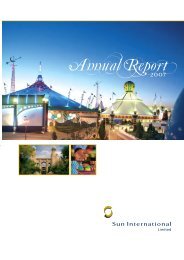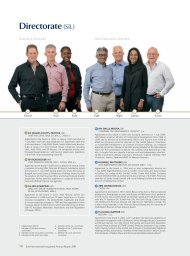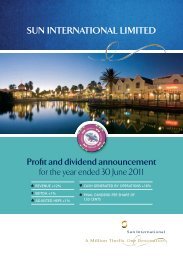PDF 25 MB - Sun International | Investor Centre
PDF 25 MB - Sun International | Investor Centre
PDF 25 MB - Sun International | Investor Centre
You also want an ePaper? Increase the reach of your titles
YUMPU automatically turns print PDFs into web optimized ePapers that Google loves.
SUN INTERNATIONAL ANNUAL REPORT ’10<br />
We again achieved a significant overall improvement in safety performance<br />
and we remain ahead of our competitors in this field. Some of the highlights<br />
were:<br />
72<br />
A 79% reduction in injuries on duty, as reported to the Compensation<br />
Commissioner: 44 vs 209 in the previous year<br />
There was an overall 37% average reduction in incidents which<br />
required treatment by doctors<br />
As a result of an increased focus on at-risk conditions/tasks and safe<br />
work procedures we achieved our target of a ratio of more lowerseverity<br />
injuries (first aid) than higher-severity injuries (medical treatment)<br />
A 79% reduction in reportable incidents<br />
An average 9.9% reduction in lost time incidents<br />
We maintained our target of zero fatalities in the workplace<br />
We continued to maintain our increased health and safety awareness<br />
levels and skills through 1 150 internal communication interventions<br />
Risk management<br />
The group has embraced robust risk management as the foundation of<br />
effective OH&S management and a group OH&S Hazard Identification<br />
and Risk Assessment Standard has been rolled out.<br />
Legal compliance<br />
Legal compliance is a minimum requirement and our internal audit<br />
department monitors OH&S compliance at all properties. The Chief<br />
Executive has overall accountability for OH&S legal compliance and to<br />
assist him in this, all operational general managers are fully responsible for<br />
OH&S compliance at their properties.<br />
Incident/injury frequency rates<br />
First aid, medical treatment (no lost time, restricted duty and lost work days),<br />
occupational diseases, noise-induced hearing loss and fatalities were<br />
continued as indicators. A leading safety indicator is near-hit incident rates.<br />
Trauma induced stress disorders (TISDs) are measured as an occupational<br />
health indicator because of our employees’ potential risk of exposure to high<br />
trauma incidents such as armed robberies and serving on emergency and<br />
first aid teams.<br />
Training awareness and competence<br />
Three group and 18 operational OH&S training workshops were conducted<br />
in the year under review and in addition to these formal training interventions,<br />
general OH&S training was conducted at most of our properties.<br />
During the year, there were 1 150 OH&S awareness communication interventions<br />
in the form of newsletters, safety talks, management sessions<br />
and e-mails.<br />
Our performance<br />
The performance results exclude Monticello, Federal Palace and head office<br />
and, unless stated otherwise, the statistics are limited to <strong>Sun</strong> <strong>International</strong><br />
employees only. We started reporting, as a voluntary option, on the OH&S<br />
performance of our stakeholders in the last financial year and this will<br />
continue to be phased in over the next two years.<br />
Near hits<br />
This indicator is a warning sign for management intervention and, if<br />
investigated and the right corrective actions are put in place, can prevent<br />
injuries. In the year under review, 68% of our properties reported nearhits.<br />
The group’s average decreased from 26.5 in last year to 8.1 in this<br />
year with a frequency rate decrease from 12.2% to 9.7% per 200 000<br />
hours worked, or 100 employees.<br />
First-aid cases (FACs) vs medical treatment cases (MTCs)<br />
On a year-on-year basis we reduced our FACs as opposed to MTCs from<br />
62% vs 38% to 68% vs 32%. Lost time cases were reduced by 53%;<br />
restricted duty cases by 41% and lost workday cases by 3%. Overall, the<br />
number of injuries requiring medical attention decreased by 37%.<br />
Trauma induced stress disorders incidents (TISD)<br />
During the year, there were no TISDs reported, compared to last year<br />
where two were reported.<br />
OH&S severity index frequency rates<br />
For the year under review, 780 OH&S incidents were reported with a rate<br />
of 10.7 per 200 000 hours worked or 100 employees.<br />
Total recordable incident frequency rate (TRIFR)<br />
This is an all-inclusive index of the higher severity incidents and is the<br />
sum of work-related fatalities, all injuries (exclusive of first-aid cases), all<br />
diagnosed occupational diseases and all noise-induced hearing loss cases.<br />
The total reportable incidents (TRIs) decreased by an average of 21% and<br />
the TRIFR average decreased from 4.3 to 3.4.<br />
Total lost time incident frequency rate (LTIFR)<br />
This is an index of work-related injuries that render the injured unable to<br />
perform normal duties for one shift or more on the day following the day<br />
of injury. It is the sum of all restricted-duty and lost workday incidents<br />
occurring per 200 000 hours worked. Lost time incidents (LTIs) for the<br />
group decreased by an average of 4.2% for the year and the average<br />
LTIRF was 2.1.<br />
The Wild Coast <strong>Sun</strong> (94%), Boardwalk (95%) and Carnival City (92%)<br />
maintained the three best scores in the group for the last two audits.<br />
The average group audit score for the last round of audits improved<br />
to 78.4%.










